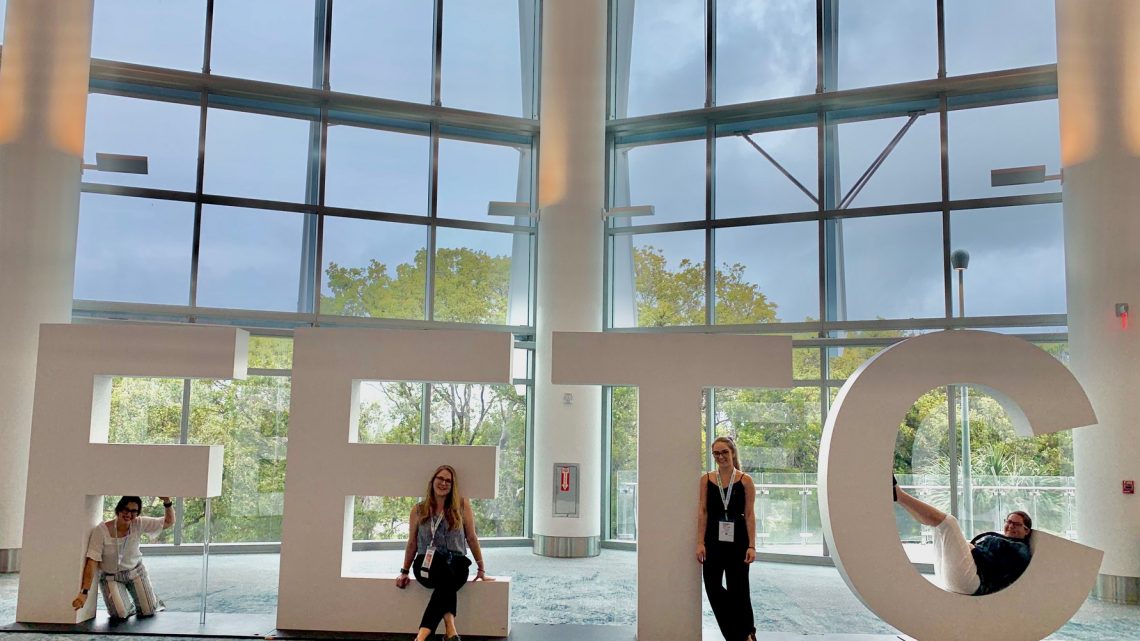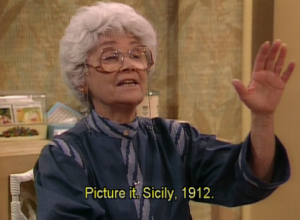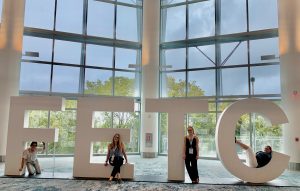
Leaping Over Coding Gatekeepers and Other Hurdles
In Retrospect
In a decade, my coding identity has run the gamut from disinterested secondary English teacher to invested facilitator.
Cue flashback (because Xennials love saying “back in my day”)…
Picture it: Wilkie, SK (middle of agricultural nowhere); the year is 2012. “Coding” is about to enter my lexicon. I teach Grade 8/9 English with minimal emphasis on computer literacy. A Grade 12 “techie” teacher from another high school presents to my class about coding. It sounds interesting, but we do not have access to 1:1 computers, and (to my young, biased mind), I wonder how I could possibly apply this to ELA. What would a classroom of future farmers care about computer programming? (facepalm!)
Fast forward: The year is 2020, right before the mic is about to drop (see: Pandemic). I am one of four tech facilitators for my division, heading to The Future of Education Technology Conference in Miami, Florida. Our purpose is to source new, worthwhile technology for classrooms, with an emphasis on coding hardware and software. After follow-up training sessions with SaskCode, I am 100% invested.

My hero, Sophia Petrillo. Copyright: Golden Girls, Touchstone Pictures
Gatekeepers and Other Hurdles
To transform a coding-resistant teacher into a tech adopter, the “in-between” must contain a series of fortunate events. In my experience, the answers were repeated exposure, courage, and experience itself. Originally, I couldn’t connect my subject area to the relevancy of coding. I wondered how coding added value to my students, classroom, and personal pedagogy. The “buy-in” hadn’t happened yet
Another full-scale deterrent was coder gatekeeping, real and imagined. With that one “gate” came a series of hurdles, acting as my personal stumbling blocks.
Bias Hurdle One: The “stereotype of the ideal coder as innately genius rather than hard-working and well-trained has remained powerful in the tech industry”(Source). Elitism within coding restricts certain groups from leaving “Plato’s Cave.”
Stumble One: I am not inherently gifted with 0’s and 1’s.

Plato’s Allegory of the Cave; artwork by Jan Saenredam, 1604.
Bias Hurdle Two: Coding is reserved for analytical, linear “black and white” thinkers.
Stumble Two: I lean toward creative, constructivist learning.
Bias Hurdle Three: According to a 2015 study reported in the Washington Post, computer science, “more than any other field, places a premium on inborn brilliance, something considered a disproportionately male trait.”
Stumble Three: I am a cisgender female.
The teacher who first introduced coding in my classroom? A white, middle-aged, cisgender male with a computer science degree. He could cite all the tech-jargon and did so fearlessly. Our blank, confused stares did not deter him. He was there to show what he knew, not what we could learn.
A New Perspective: The Other Side of the Gate
For me to hurdle clumsily but courageously over gatekeepers, I had to knock down my misconceptions about “good” coders and apply some new, improved thinking:
- Coding can be applied in every subject area. While not all students end up working in computer sciences, the skills required for coding, “thinking creatively, reasoning systematically, working collaboratively. . .are things that [students] can use no matter what” (MIT computer scientist Mitch Resnick). To begin using cross-curricular coding, educator Karly Moura suggests combining robots and maps (ELA and Social Studies), Scratch-based dictionary translation (EAL/ELL/ESL learners), creating a calculator (Mathematics), and/or writing adventure and historically accurate stories (ELA and Social Studies). The possibilities and potential are only as limited as your imagination.
- “Good” coders are made, not born. After watching my (then) 4-year-old son easily and happily code his first online game, I couldn’t dispute that some people (particularly astounding Gen. Alpha’s) are “born with it”; however, old dogs can learn new tricks. Programs like SaskCode use Arduino, Edison, and Robot Mouse to transform coding into fun learning experiences. From programming drawing robots to configuring epic Lego Battlebots, these programs allow learners to “take chances, make mistakes, and get messy” (The legendary Frizz). If we want students to fearlessly buy in, “teachers must exemplify risk-taking” (Source).
- Coders are creative; coding is creating. In the suggested short film, “Coding Stars,” Elena Silenok, the creator of Clothia.com, astutely notes: “It took me some time to realize that creating things with your hands, or creating code, creating programs, is just a different way to express creativity.” To believe that coding should stay in its analytical, linear lane and leave the creating for “artsy, tactile types” is to become a different sort of gatekeeper. There are no divisions or labels except the ones we create.

SaskCode Advertisement; Twitter (before it was desecrated).
- Coding is for everyone, but especially for underrepresented groups. We cannot deny the inherent bias and blatant sexism/racism/ageism/ableism rampant in the tech industry, but as educators, we have to push through these barriers for the next generation. Out of the four facilitators sent to Miami to lead my division’s EdTech adoption, four were self-identifying females. Programs like Girls Who Code, Coding Girls, and Black Girls Code are blazing a path for coding inclusivity. Successful coding is not about the exclusive, individual process of one innate genius; rather “the magic happens when we’re all on the same page, collaborating and building something together” (Gabe Newell, Creative Valve).

Representing women who code at FETC, 2020.
Facing Other Hurdles
Accessibility issues and the digital divide are equal deterrents and detractors; however, resourceful educators can implement the concepts of coding without relying on computers. Some unplugged coding activities to get those creative, problem-solving juices flowing are: Coding role-plays, sequential Origami design, treasure obstacle courses, follow the leader games, “If, This, Then…Art!” lessons, loop routines, beaded bracelets….the list goes on.
Further, as noted in Teachers’ Essential Guide to Coding in the Classroom, students must have certain basic skill competencies before dipping their toes into 0’s and 1’s:
- Basic computer skills
- Logic (particularly cause/effect, inferencing, and sequential scaffolding)
- Perseverance (although I would counter that coding promotes and strengthens this attribute)
- Attention to detail
Opening the Gate
To reiterate my coding journey’s main takeaways: Coding can be applied to every subject, coders are born and made, coding is a creative/ constructivist/transformational process, and – most importantly – coding is for everyone.
Implementing coding in the classroom requires the same perseverance and courage from teachers that teachers regularly require from students. Comfort zones need not apply. Bias, prejudice, and stereotypes require acknowledgment but also push-back.
Once we find ourselves on the other side of coder gatekeeping, battered but wiser from trial and error, we must not become gatekeepers ourselves. Rather, it becomes our job to swing wide the gate to ensure coding truly is for everyone.
Points to Ponder
- How comfortable are you with coding? If proficient, how did you become so? If hesitant, what prevents you from learning more?
- Are there certain students you believe do not benefit from coding?
- How do you address a student’s coding frustration if they exhibit limited perseverance?
- Do you believe coding is promoting the next generation of office labourers or innovative creators?
- When playing with Hour of Code, what activity did you explore? Would you recommend it? Why or why not?
Hi Kim. My first serious experience with coding was in SaskPolytech where I had to learn JavaScript. The way they taught it was not the greatest; my instructors threw us in the deep end with the attitude of “you’ll figure out or you’ll quit.” I think this a leftover from the olden days when coding was considered the exclusive domain of the stereotypical basement dwelling savant with the messy workstation (the “Denis Nedry” character from Jurassic Park). One of the challenges I found with learning code is that when I went to the community (websites like “Stack Overflow”, or forums) there was definitely a pervasive air of elitism and gatekeeping. Some folks were very helpful, but many (read: most) replies were dismissive and hostile (“How could anybody be this stupid, everybody who’s read any documentation should know this, etc.”). Luckily there are lots of great tutorials on YouTube and W3schools is an awesome website. I love that we are making progress with younger students but I still think there needs to be a culture shift as you get closer to the deep end. The thing that bugs me the most is that it doesn’t have to be this way. When I work with very experienced (or even professional) fighters at my martial arts club they are always extremely helpful and supportive. I wonder if people would act the same way if they were in the same room with one another and not behind a screen.
Hi Matt,
Thanks for sharing. Your comment – “the stereotypical basement dwelling savant with the messy workstation (the “Denis Nedry” character from Jurassic Park)” – made me laugh out loud. You bring up an interesting question about the elitism present in coding. Similar to you, my Krav/boxing club is highly inclusive. I remember hesitating to join because I was 30 (with no prior experience), had just had a baby, and was the only female registered at the club. I didn’t know how the other boxers or my coaches would respond…but like you, they disarmed me with their enthusiasm and openness. Why, then, not in coding and tech? In addition to keyboard warrior bravado, I wonder if it is the general “newness” of coding that leads people to gatekeep. There are many skills that were once exclusive that with time and exposure have become mainstream. My hope is that time and experience will have the same effect on coding. Fingers crossed!
Kim – great post! I really connected with your experiences in Wilkie as I am a townie where agriculture and hunting were really all that mattered…. somehow I was not into either. Anywho, we had no exposure to coding unless you decided to take Computer Science 20/30 which I attempted CS 20 and can honestly say it was one of the worst educational experiences of my life. Our computers were god awful and our teacher was the “techiest” on staff so they were tasked with teaching us. I think this had something to do with my mindset that I cannot learn code or learn how to code. Like you say in your post, the best coders are made not born…. maybe it’s time for me to learn a new skill!
Hi Bret,
Thanks for sharing so honestly. Some less-than-stellar early experiences with coding and “techy” coders can definitely sour the experience or hopes for further pursuits. As Tuesday’s class definitely showed, however, programs and mindsets are improving considerably. For every troll out there, there are 3 more people willing to help. I hope you dip your toe back in soon!
Great post, Kim! I was instantly drawn to commenting as soon as I saw the Sophia meme on your post. When coding, I explored the Dance Party on Hour of Code when we were given time to play around. I LOVED it. I appreciated how it was split into steps. I didn’t get super far on it during the 10 ish minutes of playing around. I ended up giving that link to my students to work on the following day. 10 minutes passed and I heard “Ms. McKay, look at mine!” And I was shown the same coding activity many steps passed what I did in the same amount of time. This really proves how quickly students catch on. Moving forward, I would definitely provide more challenging activities on the Hour of Code website.
Ha – thanks Maddy. If I could find a way, I’d include a Golden Girl’s reference into every blog post. Maybe I’ll set that as my goal in my next class 😉
That dance party coding looked so fun – I will be trying it with my class next week. The level of engagement/previously untapped ability in students while coding is reason enough to tread outside of our comfort zones with them. Every time my 8-year-old son surpasses my coding and computer programming understanding, I am left in awe at the potential of this next generation of learners. Thanks for sharing!
Great post and I could relate to many of your thoughts. Coding IS for everyone; even old dogs can learn new tricks. The implementation of coding does take perseverance, risk taking and courage. I plan on dedicating an entire staff meeting to coding and makerspace – to encourage the teachers on staff to take the plunge and see the many benefits it provides for the students.
Interesting post Kim!
Recently, I also came to know that coding is for everyone… And with respect to Hour of Code… I really enjoyed it and I think it is a great source of learning. It provides the user with a sense of independence. Students can learn at their own pace and in their comfort zone. Also, I think these tools helps students to learn new skills such as problem solving.
Thank you for such an engaging post.
Hi Shristy,
Thanks for the response. Out of all the EdTech we learned about this term, I am most on board with coding and makerspaces (for the exact reasons you mention). My students love the independence, creativity, and trial/error nature of coding. There’s no question they can use these skills in the “real world” when they are older. I am glad you enjoyed coding as well. It really is for everyone; it just involves going outside of our comfort zones sometimes.